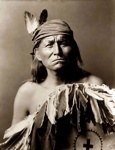Apache victory
 As we saw in Aztec collapse, while it took just two years for the Spanish to conquer the mighty Aztec and Inca civilizations, the Apaches successfully held off the Spanish for 200 years.
As we saw in Aztec collapse, while it took just two years for the Spanish to conquer the mighty Aztec and Inca civilizations, the Apaches successfully held off the Spanish for 200 years.
According to Tom Nevins the difference lay in the way the Apaches were organized as a society. The Apaches withstood the Spanish because they were decentralized.
In a decentralized organization, there’s no clear leader, no hierarchy, and no headquarters. If and when a leader does emerge, that person has little power over others. The best that person can do to influence people is to lead by example. Nevis calls this an open system, because everyone is entitled to make his or her own decisions.
This is not anarchy. There are rules and norms, but these aren’t enforced by any one person. Rather, the power is distributed among all the people and across geographic regions. There’s no Tenochchtitlan, and no Montezuma. Apache decisions were made all over the place by the people who were close to the action.
Apaches didn’t have chiefs. The had a Nant’an—a spiritual and cultural leader.
Geronimo held off the American forces for decades. Geronimo never commanded an army. He started fighting and everyone else joined in.
The traits of a decentralized society—flexibility, shared power, ambiguity—made the Apaches immune to the sort of attacks that destroyed the Aztecs and Incas.
The Aztecs and Incas were centralized, command-and-control societies organized. So were the Spanish. Nevins calls these societies “coercive” in contrast to the Apaches who were “open”.
When the Spanish encountered opposition from the Apaches they responded by eliminating the Nan’tans, just as they had disposed of Montezuma. In a coercive society, kill the leader and you control the followers.
But as soon as they killed one Nan'tan, a new one would emerge. The strategy failed because no one person was in charge. In fact, the more the Spanish attacked them the more open and decentralized and stronger they became.
By now you can see some parallels with the battle the US and it’s allies are facing in Iraq and elsewhere. But that’s not my point here.
I want you to think about dynamic church planting movements. Are they Apaches or Aztecs?
How about the movement Jesus founded? Apaches or Aztecs?
Your ministry? Apaches or Aztecs?
Your answer may determine whether you are facing victory or collapse.
Sources
 “The Starfish and the Spider: The Unstoppable Power of Leaderless Organizations” (Ori Brafman, Rod Beckstrom), ch 1.
“The Starfish and the Spider: The Unstoppable Power of Leaderless Organizations” (Ori Brafman, Rod Beckstrom), ch 1.
 Thomas Nevins (Introduction), “The Apache Indians: In Search Of The Missing Tribe” (Helge Ingstad)
Thomas Nevins (Introduction), “The Apache Indians: In Search Of The Missing Tribe” (Helge Ingstad)
